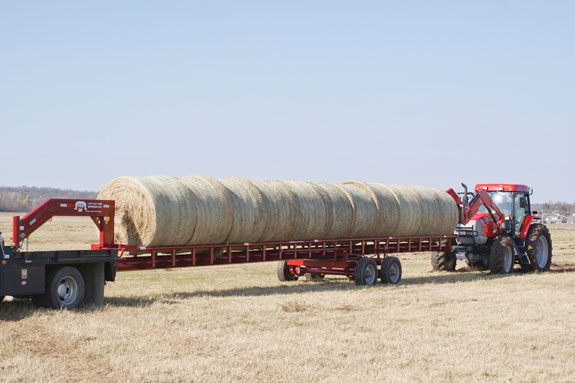But what kind is best for you? That depends on your equipment (tractor or pickup), your use (bale size, quantity and labor) and your budget.
If you’ve got enough tractors and labor and would like to minimize the upfront cost of a trailer, then traditional inline, self-unloading hay trailers are a good choice.
These trailers typically load bales with a tractor’s hayforks from the rear, until the trailer’s cradle is full.
When the trailer reaches its destination, a lever is pulled and the hay bales are rocked, then rolled off the cradle by gravity.
If a farmer or rancher is choosing a traditional inline, self-unloading hay trailer, there are two questions they need to ask: How reliable do I want the trailer to be, and how long do I want it to last?
For those hauling less hay for less time, and lighter bales, a typical trailer will do. Still, if you don’t want your hay trailer in the repair shop when it’s time to bring in the bales, it’s important to look for at least a few quality features.
For instance, it’s best to choose a trailer with a frame at least five feet wide. Many inline hay trailers only use a four-foot-wide frame to save on freight shipping cost.
But sitting a six-foot-wide bale on top of a four-foot-wide trailer frame makes a load more top-heavy and less stable.
This becomes a problem on fields filled with berms, terraces, gopher holes and ditches. Too often, when narrow trailers hit a ditch, the whole load is dumped.

With many trailers hauling 6,000 to 12,000 pounds of bales per load, another caution is to choose a trailer with a double-latch system, since latches hold the load in place until it’s ready to dump.
Single-latch trailers are prone to tearing the sidewall off the main tube over time, which can require cutting off the latch, regrinding and rewelding.
A double-latch system cuts the latches’ metal fatigue in half as bale weight is dispersed, improving safety and reliability. A linkage between the latches also allows them to operate with only one lever.
For heavy bale loads, more loads or long use, consider a hay trailer that’s built to last. Besides an extra wide five-foot frame and double latches, these trailers usually use more steel in the cradle, neck, axles, main tube and rail supports.
Since the main tube is the backbone of the hay trailer, some are built heavier than other manufacturers; for example, built with an 8 5/8-inch OD .352 wall thick main tube where typical hay trailers use eight-inch square .188 wall tubing or 8 5/8-inch OD .250 wall.
Rail supports are also critical because they carry most of the bale weight and should be made of more steel.
Since bale capacity can determine how many trips you have to make to clear the field, it’s important to consider this as well.
Hay trailers typically range from 21 to 40 feet long, with a 32-foot trailer carrying about six to eight bales. When capacity is a concern, it might make sense to consider some of the larger inline hay trailers which can haul nine to 11 bales at once.

Farmers or ranchers wanting the speed and convenience of staying in their tractor or pickup while loading or unloading bales should consider self-loading/unloading hay trailers.
With these hydraulically operated trailers, it’s a one-person operation that doesn’t take physical strength. If they choose a pickup-capable version, it doesn’t even require a tractor.
In fact, some farmers and ranchers find they can dramatically improve productivity with their existing equipment if their wife hauls baled hay in a pickup-pulled trailer while they bale hay with the tractor.
This can remove the bottleneck of waiting for one person to do all the work with a single tractor. FG
Del Williams is a technical writer based in Torrance, California. For more information, e-mail press@powerpr.com
PHOTO:
Photos courtesy of Bob Studebaker, Go Bob Pipe and Steel (www.gobobpipe.com).











